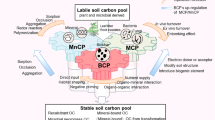Abstract
Controversies exist in interpreting rhizosphere C flow obtained by different 14CO2 labelling methods. However, there is a need for the standardisation of methods in order to be able to compare values obtained for different plants, different stages of development and different habitats. Perennial bromegrass (Bromus erectus Huds) grown in soils of different fertility was exposed to a 14CO2 atmosphere for different periods of time: 1 h, 298 h and 78 days. The evolution of 14CO2 in the soil was measured during and after labelling. The 14C contents of plant and rhizosphere compartments were then estimated. The time-sequence of the rate of 14CO2 evolution after 1 h of labelling, indicated a maximum after around 20 h, followed by an exponential decrease. When expressed as a percentage of net 14C assimilation, root-soil respiration accounted for 14% and 18% in the nutrient-poor and nutrient-rich soils, respectively. Integration of the hourly values over several days showed that the dynamics of the evolution rate were similar for the 298-h and 78-day experiments, thus indicating that rhizosphere C flow was dominated by newly assimilated C. This was confirmed by the proportions of below-ground 14C, measured for roots, respiration and soil, which were not significantly affected by the labelling regime. The differences were, however, found to be significant between the two types of soils. The conclusion was that the conditions for plant growth during labelling were more important than the length of time of labelling, and that this explained the discrepancies in the literature-cited values. A succession of short-term 14C labelling of plants at different development stages followed by an allocation period of about 1 week is proposed to give a reliable estimation of the dynamics of C flow in the rhizosphere.
Similar content being viewed by others
Author information
Authors and Affiliations
Additional information
Received: 7 June 1999
Rights and permissions
About this article
Cite this article
Warembourg, F., Estelrich, H. Towards a better understanding of carbon flow in the rhizosphere: a time-dependent approach using carbon-14. Biol Fertil Soils 30, 528–534 (2000). https://doi.org/10.1007/s003740050032
Issue Date:
DOI: https://doi.org/10.1007/s003740050032




